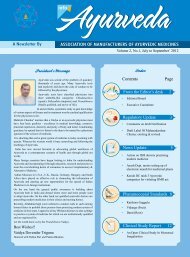Wishing our members a very auspicious and delightful Navratri ...
Wishing our members a very auspicious and delightful Navratri ...
Wishing our members a very auspicious and delightful Navratri ...
Create successful ePaper yourself
Turn your PDF publications into a flip-book with our unique Google optimized e-Paper software.
<strong>Wishing</strong> <strong>our</strong> <strong>members</strong><br />
a <strong>very</strong> <strong>auspicious</strong> <strong>and</strong> <strong>delightful</strong><br />
<strong>Navratri</strong>, Durga pooja<br />
<strong>and</strong> Dushera<br />
Volume. 2 No.2 Oct. - Dec., 2012<br />
Index<br />
Contents Page<br />
From the Editor’s desk 2<br />
• Editorial Board<br />
• Executive Committee<br />
Regulatory Update 3<br />
• Draft Notification from Department<br />
of AYUSH<br />
News Update 5<br />
• Neem on ASEAN’s negative list<br />
• Efficacy of most herbal drugs need to be<br />
doubted<br />
• Dept of Ayush plans to support effectiveness<br />
studies of 500 select ASU Drugs<br />
Pharamocopial St<strong>and</strong>ards 9<br />
• Marichadi Gutika<br />
• Guda<br />
• Yava<br />
• Yavaksara<br />
Clinical Study 13<br />
• Management of Osteoarthritis
From the Editor’s desk<br />
Dear Members,<br />
Benefits of Neem have been known to all of us since the time<br />
immemorial.<br />
In India, the plant is variously known as “Sacred Tree,” “Heal All,”<br />
“Nature’s Drugstore,” “Village Pharmacy” <strong>and</strong> “Panacea for all<br />
diseases”. Products made from neem trees have been used in <strong>our</strong><br />
country for over two millennia for their medicinal properties<br />
Sanskrit medical writings refer to the usage of neem’s fruits, seeds,<br />
oil, leaves, roots <strong>and</strong> bark for various benefits.<br />
Modern scientific research has also confirmed neem’s curative<br />
benefits in many diseases <strong>and</strong> has provided indications that neem<br />
might be used much more widely in coming future.<br />
Neem is known to be anthelmintic, antifungal, antidiabetic,<br />
antibacterial, antiviral, contraceptive <strong>and</strong> sedative. It is considered<br />
as a major component in Ayurvedic <strong>and</strong> Unani medicine <strong>and</strong> is<br />
particularly prescribed for skin diseases.<br />
Substantial experimental evidence <strong>and</strong> clinical data is today available<br />
in support of the efficacy of neem.<br />
Having known this, it is indeed <strong>very</strong> unfortunate that herbs like neem<br />
are being considered under negative list of plants in the ASEAN<br />
countries.<br />
Recently, a conference was held in Singapore wherein an expert<br />
committee of TMHS intended the inclusion of neem in the ‘ASEAN’s<br />
list of negative ingredients for traditional medicine <strong>and</strong> health<br />
supplement (TMHS)’<br />
The product working group (PWG) discussed this <strong>and</strong> is said to be<br />
finalising the inclusion of Azadirachta indica or neem in the negative<br />
list which may result in unnecessary confusion among the public<br />
regarding such a commonly used <strong>and</strong> time tested medicinal plant.<br />
This could become a serious threat to jeopardize the exports business<br />
of AYUSH Industry.<br />
AMAM, strongly criticizes this inclusion of ‘Azadirachta indica’ or<br />
neem/nimba in the ASEAN list of Negative Ingredients for Traditional<br />
Medicine <strong>and</strong> Health Supplement (TMHS) by the ‘Product Working<br />
Group’ (PWG) which happens to be an expert committee group under<br />
TMHS.<br />
The Association has already requested the requisite intervention of<br />
the department of Ayush <strong>and</strong> Ministry of health on this issue.<br />
By targeting neem, without credible evidence, the report sends a<br />
wrong message to the entire globe involved in trading <strong>and</strong> developing<br />
products based on the traditional science.<br />
We invite view of <strong>our</strong> fellow <strong>members</strong> on the above issue.<br />
Warm Regards,<br />
Dr. Manju Rakesh<br />
On behalf of full editorial board<br />
Disclaimer: Articles in the newsletter are written by independent individuals. News Clips of Upcoming<br />
Events, Govt. Notifications, Schemes have been taken from different s<strong>our</strong>ces. Their opinions do not<br />
necessarily reflect those of Info Ayurveda. They are put here for interest <strong>and</strong> reference only. None of the<br />
contributors, sponsors, administrators, or anyone else connected with Info Ayurveda in any way whatsoever<br />
shall be responsible for the appearance of any inaccurate information or for y<strong>our</strong> use of the information<br />
contained in the newsletter.<br />
Members of AMAM’S Management<br />
Committee<br />
Patron<br />
Jt. Secretary<br />
Vaidya Brahaspati Dev Triguna Ajay Sharma<br />
Ashok Ch<strong>and</strong> Burman<br />
Shri Baidyanath Ayurved Bhawan,<br />
Suresh Sharma<br />
Pradip Burman<br />
New Delhi<br />
E-mail: ajdelhi@msn.com<br />
Arun Chauhan<br />
President<br />
BACFO Pharmaceuticals (India) Ltd.<br />
Vaidya Devender Triguna<br />
Tel: 011-24354141<br />
E-mail: chauhanarun@akcgroup.com<br />
Dr. N.B. Brindavanam<br />
Dabur India Limited<br />
Vice President<br />
Anurag Sharma<br />
Shri Baidyanath Ayurved Bhawan<br />
Ltd., (Jhansi)<br />
E-mail: baba@dabur.com<br />
M. J. Saxena<br />
Sanat Laboratories Ltd.<br />
E-mail: mjsaxena@anatproducts.co.in<br />
E-mail: anurag@baidyanathayurved.com<br />
Asad Mueed<br />
Hamdard (WAKF) Laboratories<br />
E-mail: amueed@hamdardindia.com<br />
Devendra Garg<br />
Dabur India Limited<br />
E-mail: gargd@dabur.com<br />
Ravi Prasad<br />
The Himalaya Drug Co.<br />
E-mail: ravi.prasad@himalayahealthcare.com<br />
Members<br />
Vijay Grover<br />
Kamal Pharmacy, New Delhi<br />
E-mail: vijay@kamalpharmacy.com<br />
Pramod Sharma<br />
Shri Baidyanath Ayurved Bhawan<br />
Ltd. Patna<br />
E-mail: pramodsharma54@yahoo.com<br />
Dr. Manju Rakesh<br />
Dabur India Limited<br />
Hon. Gen. Secretary<br />
Pradeep Multani<br />
Multani Pharmaceuticals Ltd.<br />
e-mail: chairman@multaniayurved.org<br />
Treasurer<br />
Tejinder Singh<br />
Dabur India Limited<br />
e-mail: singht@dabur.com<br />
E-mail: rakeshm@dabur.com<br />
Amit Agarwal<br />
Natural Remedies<br />
E-mail: amit@naturalremedies.com<br />
Dr. Anantha Narayana D B,<br />
Ph.D., Consultant<br />
Email: dba.narayana@gmail.com<br />
Editorial Board<br />
Chief Editor:<br />
Mr. Pradeep Multani<br />
Honorary General Secretary AMAM<br />
Chairman Multani Pharmaceutical Limited<br />
36-H Connaught place, New Delhi- 1<br />
Editor:<br />
Dr. Manju Rakesh<br />
Dabur India Limited, Plot No. 22, Site IV,<br />
Sahibabad - 201010, Ghaziabad (U.P.)<br />
Mr. Anurag Sharma, Executive Director<br />
Shri Baidyanath Ayurved Bhawan Pvt. Ltd. (Jhansi)<br />
B- 6/5, Safdarjung Enclave, New Delhi<br />
Mr. Asad Mueed, Director<br />
Hamdard (WAKF) Laboratories, Asaf Ali Road, New Delhi – 2<br />
Mr. Ajay Sharma, President<br />
Shri Baidyanath Ayurved Bhawan, Naini,<br />
28, Ishwar Nagar East, New Delhi – 65<br />
A Publication of:<br />
Association of Manufacturers of Ayurvedic Medicines<br />
Regd. Office: 22, Site –IV, Sahibabad,<br />
Ghaziabad - 201010 (UP), Tel: 0120 4378400, Fax: 0120 4376909<br />
Correspondence Address: H-36, Connaught Place, New Delhi-110001,<br />
Tel: 011-23350062, Fax: 011-23350063<br />
E-mail : amamindia@gmail.com website: www.amam-ayurveda.org<br />
info Ayurveda, Volume 2, No. 2, Oct.-Dec.,’ 2012 2
D ear Readers,<br />
MiNiSTRy of HEAlTH AND fAMily WElfARE<br />
(Department of Ayurveda, Yoga <strong>and</strong> Naturopathy, Unani, Siddha <strong>and</strong> Homeopathy)<br />
NOTIFICATION<br />
New Delhi, the 30th July, 2012<br />
G.S.R. 597(E)- The following draft of certain rules further to amend the Drugs <strong>and</strong> Cosmetics Rules,<br />
1945, which the Central Government proposes to make rules in exercise of the power conferred by<br />
section 33N of the Drugs <strong>and</strong> Consmetics Act. 1940 (23 of 1940), is hereby published as required by the<br />
said section for the information of all persons likely to be affected thereby <strong>and</strong> notice is hereby given<br />
that the said draft rules will be taken into consideration after the expiry of a period of forty five days<br />
from the date on which copies of the Official Gazette in which this notification is published are made<br />
available to public;<br />
Regulatory Update<br />
Dept of AYUSH, Ministry of Health <strong>and</strong> family welfare recently issued a draft notification to amend the D & C Rules, we are reproducing the<br />
same for y<strong>our</strong> kind information <strong>and</strong> perusal. Please read on…..<br />
Objections or suggestions, if any, may be addressed to the Secreatary (Department of Ayurveda, Yoga<br />
<strong>and</strong> Naturopathy, Unani, Sidha annd Homeopathy) (AYUSH) Ministry of health <strong>and</strong> Femily Welfare,<br />
India Red Cross Society Building. New Delhi 110 001;<br />
Any objection or suggestion, which may be received from any person with respect to the said draft rules<br />
within the period specified above, will be taken into consideration by the Central Government.<br />
info Ayurveda, Volume 2, No. 2, Oct.-Dec.,’ 2012 3
DRAFT RULE<br />
1. (1) These rules may be called the Drugs <strong>and</strong> Cosmetic (5th Amendment) Rules, 2012<br />
(2) They shall come into force the date of their final publication in the offical Gazette<br />
2. In the Drugs <strong>and</strong> Cosmetics Rules, 1945, in rule 157 after sub-rule (1A) the following sub-rules shall be<br />
inserted, namely:-<br />
“(1B) No manufacturer shall be allowed to use any prefix or suffix with the Ayurveda Siddha <strong>and</strong> Unani<br />
Medicine defined under clause (a) of section 3 of the Act <strong>and</strong> the rules made thereunder.<br />
(1C) No medicine manufactured under the definition of clause (h) of section 3 of the Act should resemble<br />
or mimic the names of formulations mentioned in the books of First Schedule of the Drugs <strong>and</strong> Cosmetics<br />
Act 1940.”<br />
[No. K. 11020/06/2011-DCC (AYUSH)]<br />
BALA PRASAD, Jt. Secy.<br />
Note: The Principal rules were published in Official Gazette Vide Notification No. 1:28-10j 45-11(1).<br />
dated 21-12-1945 <strong>and</strong> the last amended vide G.S.R. No. 573 (E), dated 17-0-2012<br />
Ancient Wisdom<br />
Knowledge of Sakti leads to salvation. “Sakti-Jnanam Vina Devi Nirvanam Naiva Jayate—O Devi! Without the<br />
knowledge of Sakti, Mukti cannot be attained”—says Siva to Devi. The Jiva or the individual soul thinks, when he is<br />
under the influence of Maya, that he is the doer <strong>and</strong> the enjoyer <strong>and</strong> identifies himself with the body. Through the grace of<br />
Sakti <strong>and</strong> through Sadhana or self-culture, the individual soul frees himself from all fetters <strong>and</strong> attains spiritual insight<br />
<strong>and</strong> merges himself in the Supreme.<br />
Worship of the Divine Mother, intense faith <strong>and</strong> perfect devotion <strong>and</strong> self-surrender, will help you to attain Her grace.<br />
Through Her grace alone you can attain Knowledge of the Imperishable.<br />
Glory to Sri Tripurasundari, the World-Mother, who is also Rajarajesvari <strong>and</strong> Lalita-Devi. May Her blessings be upon<br />
you all. May you all obtain the grace of Sakti, the Universal Mother <strong>and</strong> enjoy the supreme bliss of final emancipation.<br />
info Ayurveda, Volume 2, No. 2, Oct.-Dec.,’ 2012 4
News Update<br />
Neem on ASEAN’s negative list<br />
Praveen Bose / Chennai/ Bangalore Sep 04, 2012<br />
The traditional Indian drug makers are now a worried lot. An innocuous document revealed at a conference<br />
held in Singapore on June 29-30, 2012, threatens to jeopardise the export prospects of the whole Ayurveda<br />
industry.<br />
In a letter to the ministry of health <strong>and</strong> family welfare, the Association of Manufacturers of Ayurvedic Medicines<br />
(AMAM) has expressed its fears over the snowballing of this move. It could affect exports to other<br />
parts of the world, believes AMAM.<br />
Pradeep Multani, honorary general secretary of AMAM, told Business St<strong>and</strong>ard, “The move will affect<br />
Ayurveda, Siddha <strong>and</strong> Unani (ASU) branches of traditional medicines. It could have a devastating effect on<br />
the trade in ASU herbs <strong>and</strong> drugs. With India set to sign the FTA with ASEAN, it could ultimately even affect<br />
the sales of these products in India.” Multani expressed his fears that it could be first of many more herbs that<br />
could be targeted that are used in these traditional systems of medicines.<br />
With India in talks with the ASEAN <strong>members</strong> for a Free Trade Agreement (FTA), Ayurveda was expected to<br />
play a major role in healthcare exports. “The local <strong>and</strong> allopathic drug makers there are probably fearing a<br />
threat,” added Multani. Not all ASEAN countries though are keen to accept Indonesia’s move.<br />
Philipe Haydon, CEO, The Himalaya Drug Company, said, “Many other countries may take a cue from this<br />
<strong>and</strong> restrict imports of these products.” According to Pharmexcil (Pharmaceuticals Export Promotion Council<br />
Of India), set up by Ministry of Commerce & Industry, neem is among the top 25 herbal <strong>and</strong> AYUSH<br />
product to be exported. It generated Rs 33.98 crore in 2009-10, which was double that of the previous year.<br />
Care Kerala estimates that the total market for products containing neem <strong>and</strong> neem extracts is Rs 500 crore.<br />
Dr K G Raveedran, medical director, Coimbatore Arya Vaidya Pharmacy, sees an international conspiracy<br />
behind this, saying there’s an international lobby trying to check the spread of Ayurveda from India. To prove<br />
his point, he says how the US <strong>and</strong> UK have set up their own Ayurveda universities <strong>and</strong> recognise degrees<br />
only from there for doctors wanting to practise Ayurveda there.<br />
“This looks just like an extension of that,” added Dr Raveendran.<br />
Laments Dr Raveendran: “The Indian government does not have experts advising on the subject. We are<br />
always looking for endorsements from the West before accepting a drug. We have asked the Centre to intervene,<br />
but the response has been cold.” He asserts that neem is the most important ingredient in Ayurveda.<br />
According to Mumbai-based NGO Neem Foundation, neem is used to treat rashes, wounds, chicken pox,<br />
ulcers <strong>and</strong> jaundice.<br />
C<strong>our</strong>tesy: Business St<strong>and</strong>ard<br />
info Ayurveda, Volume 2, No. 2, Oct.-Dec.,’ 2012 5
Efficacy of most herbal drugs need to be<br />
doubted as several raw drugs not available<br />
in market<br />
Peethaambaran Kunnathoor, Chennai<br />
Wednesday, July 04, 2012<br />
The claims about the quality of most of the herbal drugs available today, especially in Ayurveda <strong>and</strong><br />
Siddha, are questionable because of non-availability of certain key raw drugs <strong>and</strong> other malpractices<br />
impacting the quality of these ingredients, according to a study conducted by a member of the<br />
Central Council of Indian Medicine (CCIM).<br />
Adulteration <strong>and</strong> substitution of raw materials are the two major factors that lead to the poor quality<br />
of conventional ayurvedic <strong>and</strong> Siddha medicines, said Dr K G Viswanathan, the CCIM member <strong>and</strong><br />
the principal of Vaidyaratnam Ayurveda College in Thrissur in Kerala.<br />
According to him some of the major manufacturing companies have stopped the production of<br />
certain key ayurvedic drugs because of shortage of raw drugs. He said the conventional Ayurveda<br />
medicine for fever “Draakshaadi Kashaayam” is not available today because the main ingredient of<br />
its production, the roots of “Kumizhu” (Gmelina arborea), is not available.<br />
“If the medicine is available anywhere, its quality has to be tested as there is no substitution for its<br />
ingredients, especially for “Kumizhu”. The tree itself is not seen anywhere. So we are suspicious<br />
of the quality of ‘Draakshaadi Kashaayam’ if it is available in any shop. The production of the<br />
Kashaayam was stopped years ago,” he told Pharmabiz in a telephonic conversation.<br />
There are Draakshaadi tablets <strong>and</strong> Arishtams coming to Kerala from other states claiming as drugs<br />
made from the roots of ‘Kumizhu’, but the veracity of those claims is also questionable, he said.<br />
There are more than 60 species of medicinal plants in the list of endangered species <strong>and</strong> government<br />
has banned their collection for commercial production of medicines. Even for samples for the<br />
purpose of study, special permission is required from the forest department. Collection of the plants<br />
‘Kottam’ (Saussurea lappa), used for the manufacture of the popular ‘Kottamchukkaathi Thailam”,<br />
‘Rakthach<strong>and</strong>anam’ (Red s<strong>and</strong>alwood) used for “shaarivadyaasavam” <strong>and</strong> the bark of Ashoka tree<br />
(Sarca indica) used for ‘Ashokaarishtam’ is restrained by laws. “In such a situation, the manufacturing<br />
companies are forced to stop production of these drugs or use substitutions which will impact<br />
the quality of the drugs”, Dr Viswanathan said. He added that several conventional ‘Kashaayams’<br />
are not available now in the market due to the non-availability of raw materials.<br />
info Ayurveda, Volume 2, No. 2, Oct.-Dec.,’ 2012 6
The bark of Ashoka tree is <strong>very</strong> much beneficial for women who suffer from irregular or painful<br />
menstruation. It is also useful in internal bleeding haemorrhoids <strong>and</strong> haemorrhagic dysentery, the<br />
doctor said.<br />
For industry purpose, sufficient quantity of these raw drugs cannot be assured. In his study report,<br />
Dr Viswanathan says that almost all the raw drugs available today seem to be suspicious of their<br />
quality. The manufacturers claim that they bring these rare species of plants from north India, but<br />
the quality of the products has to be questioned as in the local herbal markets in north India more<br />
adulteration <strong>and</strong> substitutions take place. These malpractices may be deliberate or sometimes unintentional,<br />
but it affects the efficiency of the drugs. In place of genuine drugs, substitutions are taking<br />
place where the raw drugs have similar appearance to that of genuine drugs <strong>and</strong> are deliberately<br />
sold in some herbal markets, the CCIM member alleged.<br />
Further, the study shows that, the recent habitat destruction being occurred due to infrastructure<br />
development for urbanization <strong>and</strong> over exploitation by the increasing number of manufacturers,<br />
many of the ‘annual herbs’ <strong>and</strong> bio diversity spots are permanently getting depleted <strong>and</strong> destroyed<br />
at an alarming rate. The road sides <strong>and</strong> village c<strong>our</strong>t yards in Kerala, once up on a time, were rife<br />
with medicinal plants, shrubs <strong>and</strong> annual herbs like “Kurunthotti” (Sida rhombi folia), Chittamruth<br />
(Tinospora cordifolia), Vayalchulli (Hygrophila Auriculata), Keezharnelli (Phyllanthus amarus)<br />
etc. are now permanently getting lost.<br />
The doctor said increase in the use of drugs also cause for shortage of raw drugs. In the year 1990,<br />
Kerala had only 200 manufacturing units, the number has increased to 700 in 2012. Apart from<br />
production of number of medicines, the quantity also has increased. Considering such fast rate of<br />
growth of this segment, measures have to be taken for development of medicinal plants.<br />
The study recommends for cultivation of medicinal plants by hi-tech methods with the help of<br />
agricultural universities. Besides community herbal garden, kitchen garden, medicinal plant board<br />
projects etc. should be enc<strong>our</strong>aged. Coordinated efforts of the departments of Forest, Agriculture<br />
<strong>and</strong> Health must be initiated <strong>and</strong> opportunities for researches in the field should also be given.<br />
Dr Viswanathan said that he would submit his report to the government of Kerala for Vision 2030<br />
<strong>and</strong> also to the Central Medicinal Plant Board.<br />
C<strong>our</strong>tesy: PHARMABIZ.com<br />
info Ayurveda, Volume 2, No. 2, Oct.-Dec.,’ 2012 7
Dept. of Ayush plans to support effectiveness<br />
studies of 500 select ASU drugs for better<br />
global recognition<br />
Joseph Alex<strong>and</strong>er, New Delhi<br />
Monday, July 16, 2012<br />
The Department of Ayush may initiate a scheme to support biological activity <strong>and</strong> effectiveness studies<br />
of 500 select Ayurveda, Siddha <strong>and</strong> Unani (ASU) medicines so that they get a wider acceptance in the<br />
international markets <strong>and</strong> as part of further streamlining the regulations <strong>and</strong> st<strong>and</strong>ards in the sector.<br />
The Steering Committee of the Planning Commission had made recommendations for supporting shelf<br />
life studies, development of phyto-chemical marker compounds, safety studies, biological activity studies<br />
<strong>and</strong> efficacy/effectiveness of 500 ASU drugs. The proposal is being pursued with the Planning Commission<br />
for approval, s<strong>our</strong>ces in the department said.<br />
Other recommendations of the panel included development of new scientific monographs <strong>and</strong> revision<br />
of already published monographs, selection of priority drugs with high market potential by the Pharmacopoeia<br />
Commission of Indian Medicine <strong>and</strong> development of Ayush drug dossiers to facilitate entry of<br />
Ayush drugs in the international market.<br />
Elaborating on the specific achievements of the Department in the last five years in the regulatory areas,<br />
an official of the Department said three national institutes <strong>and</strong> a Pharmacopoeia Commission of Indian<br />
Medicine have been/are being set up.<br />
Publication of pharmacopoeial st<strong>and</strong>ards <strong>and</strong> St<strong>and</strong>ard Operating Procedures (SOPs) of 152 ayurvedic<br />
formulations, publication of pharmacopoeial monographs of 101 single plant drugs <strong>and</strong> 21 minerals,<br />
publication of macro <strong>and</strong> microscopic <strong>and</strong> TLC atlases of 172 drugs, <strong>and</strong> development of eight community<br />
herbal monographs in the format given by European Medicines Evaluation Agency (EMEA) for<br />
submission to European Union were the other highlights of the performance.<br />
The Steering Committee of the Planning Commission also had recommended Rs.50 crore towards the<br />
activities in the regulatory area for the current Five Year Plan. The amount was sought for augmenting<br />
pharmacopoeia work to develop 1000 monographs <strong>and</strong> strengthening Pharmacopoeia Commission <strong>and</strong><br />
associated laboratories to accelerate the work of st<strong>and</strong>ardization <strong>and</strong> quality parameters of ASU drugs<br />
as per global requirements <strong>and</strong> acceptability, to take up development of monographs of such medicinal<br />
plants as are widely used in folklore/tribal medicine but not documented in ASU literature <strong>and</strong> to work<br />
on the lines of other Pharmacopoeia Commissions of the world.<br />
C<strong>our</strong>tesy: PHARMABIZ.com<br />
info Ayurveda, Volume 2, No. 2, Oct.-Dec.,’ 2012 8
Pharmocopial St<strong>and</strong>ards For Ayurvedic Formulations<br />
<strong>and</strong> Raw Materials<br />
efjpa d’kZek= L;kr~ fiIiyh d’kZlfEerk AA93AA<br />
v/kZd’kksZ ;o{kkj% d’kZ;qXea p nkfMee~ A<br />
,rPpw.khZd`ra ;qT;kn’Vd’kZxqMsu fgAA94AA<br />
“kk.kizek.ka xqfVdk d`Rok oD=s fo/kkj;sr~A<br />
vL;k% izHkkokr~ losZ·fi dklk ;kUR;so lM~-{k;e~ AA95AA<br />
¼“kkM~-xZ/kjlafgrk] e/;e[k.M] v/;k; 7] 13&15AA½<br />
1. Maricha (Fr.) 12 g<br />
2. Pippali (Fr.) 12 g<br />
3. Yavakshara (Yava) (Pl.) 6 g<br />
4. Dadima (Fr.R.) 24 g<br />
5. Guda 96 g<br />
Dose: 3 g (dissolved slowly in the mouth)<br />
important Therapeutic Uses:<br />
Kasa, Shvasa<br />
MARiCHADi GUTiKA<br />
(API Part I, Page 149)<br />
DADiMA (fruit Rind)<br />
(API Part I, Vol. - IV, Page 19)<br />
Dadima consists of dried fruit rind (pericarp) of Punica granatum Linn.<br />
(Fam. Punicaceae), a large deciduous shrub or a small tree, found wild in<br />
the warm valleys of the outer hills of Himalayas between 900 to 1800 m<br />
<strong>and</strong> also cultivated in many parts of the country.<br />
SyNoNyMS<br />
Sanskrit : Dantabija, Lohitapushpa<br />
Assamese : Dalim<br />
Bengali: Dadima, Dalimgach, Dalim<br />
English: Pomenagrate<br />
Gujrati: Dadam, Dadam phala<br />
Hindi: Anar, Anar-ke-per<br />
Kannada: Dalimba, Dalimbe haonu<br />
Malayalam: Mathalam<br />
Marathi: Dalimba<br />
Oriya: Dalimba<br />
Punjabi: Anar<br />
Tamil: Madulam Pazham<br />
Telugu: Dadimbakaya, Dadimma<br />
Urdu: Anar<br />
DESCRiPTioN<br />
a) Macroscopic<br />
Drug occurs in 0.1 to 0.5 cm thick, more or less concave, salver- shaped<br />
pieces, some pieces showing residual carpel walls <strong>and</strong> some having<br />
persistent toothed calyx tube alongwith withered stamens, styles <strong>and</strong> a<br />
few seeds; coriaceous, tough <strong>and</strong> nearly smooth; brown to reddish-brown<br />
externally <strong>and</strong> brownish-yellow internally; bearing impressions left by<br />
seeds; fracture, short; od<strong>our</strong> not distinct; taste, astringent.<br />
b) Microscopic<br />
Epicarp single layered covered with thick cuticle; mesocarp consists of<br />
a wide zone of oval to polygonal thin walled parenchymatous cells; a<br />
few fibro-vascular bundles, tanniniferous vessels, secretory canals, oil<br />
globules, single <strong>and</strong> a number of groups of round or oval to elongated<br />
stone cells, simple <strong>and</strong> compound starch grains having 2 or 3 components<br />
with concentric striations <strong>and</strong> central hilum, <strong>and</strong> rosette crystals of calcium<br />
oxalate present in mesocarp.<br />
Powder - Yellowish-brown; shows single or groups of stone cells; oval to<br />
polygonal, parenchymatous cells in surface view; vessels with scalariform<br />
thickening, tanniniferous vessels <strong>and</strong> a few rosette crystals of calcium<br />
oxalate <strong>and</strong> rounded to oval starch grains, measuring 3 to 5 μ in dia.<br />
iDENTiTy, PURiTy AND STRENGTH<br />
foreign matter: Not more than 2 per cent,<br />
Total Ash: Not more than 4 per cent,<br />
Acid-insoluble ash: Not more than 0.4 per cent,<br />
Alcohol-soluble extractive: Not less than 9 per cent,<br />
Water-soluble extractive: Not less than 20 per cent,<br />
T.l.C.<br />
T.L.C of alcoholic extract on Silica gel ‘G’ plate using Chloroform:<br />
Ethylacetate : Formic acid (5:4:1) shows in visible light one spot at Rf.<br />
0.74 (bluish grey). Under U.V. (366 nm) one fluorescent zone is visible<br />
at Rf. 0.74 (dark blue). On exposure to Iodine vap<strong>our</strong> two spots appear<br />
at 0.74 (dirty yellow) <strong>and</strong> 0.95 (yellow). On spraying with 10% aqueous<br />
Ferric chloride reagent one spot appears at Rf. 0.74.(blue). On spraying<br />
with 5% Mathanolic-Sulphuric Acid <strong>and</strong> heating the plate for ten minutes<br />
at 110°C two spots appear at Rf. 0.74 (brownish grey) <strong>and</strong> 0.95 (violet).<br />
CoNSTiTUENTS - Tannic acid, Sugar <strong>and</strong> Gum<br />
PRoPERTiES AND ACTioN<br />
Rasa: Kashaya, Amla<br />
Guna: Laghu, Snigdha<br />
Virya: Anushna<br />
Vipaka: Katu<br />
Karma: Vata Kaphahara, Vranaropaka, Grahi<br />
iMPoRTANT foRMUlATioNS - Khadiradi Gutika, Mritasanjivani<br />
Sura, Kalyanaka Ghrita, Marichadi Gutika, Nilikadya Taila<br />
THERAPEUTiC USES - Daha, Jvara, Katha Roga, Mukha daurg<strong>and</strong>hya,<br />
Aruchi, Amlapitta, Atisara, Pravahika, Raktapitta, Raktavikara, Kasa<br />
DoSE - Powder 3-6 g<br />
info Ayurveda, Volume 2, No. 2, Oct.-Dec.,’ 2012 9
GUDA (Jaggery)<br />
(API Part I, Vol. - VI, Page 206)<br />
Guda is obtained by concentrating juice expressed from the stems<br />
of Saccharum officinarum L. (Fam. Poaceae) with or without prior<br />
purification of the juice, followed by cooling.<br />
SyNoNyMS<br />
Ben: Guda<br />
Eng.: Jaggery<br />
Hin. : Guda<br />
Kan.: Bella<br />
Mal. : Sarkara<br />
Mar. : Guda<br />
Pun. : Guda<br />
Tam.: Vellam<br />
Tel.: Bellam<br />
Urdu: Guda<br />
DESCRiPTioN<br />
It is light yellow to reddish brown solid, blocks or spherical solid forms<br />
or in the form of coarse granules with pleasant <strong>and</strong> characteristic od<strong>our</strong>.<br />
It does not show the presence of insects, vegetable debris or fibers when<br />
examined with naked eyes in daylight.<br />
iDENTiTy, PURiTy AND STRENGTH<br />
loss on drying – Not more than 10 percent (other than that of the liquid<br />
or semi-liquid variety)<br />
Total Ash: Not more than 6 per cent,<br />
Acid-insoluble ash: Not more than 0.5 per cent,<br />
Water-soluble ash: Not less than 2 per cent,<br />
Total Sugar: Not less than 90 per cent,<br />
Sucrose: Not less than 60 per cent,<br />
Sulphur di oxide concentration: Not more than 70 ppm<br />
Heavy Metal: Complies with API<br />
Microbial limits: Complies with API<br />
Pesticide residue: Complies with API<br />
PRoPERTiES AND ACTioN<br />
Rasa: Madhura<br />
Guna: Snigdha, Isatksariya<br />
Virya: Naatishita<br />
Vipaka: Madhura<br />
Karma: Svadukara, Rakta shodhaka, Na atipittajajit, Kaphavriddhikara,<br />
Vataghna, Krimivrddhikara, Balya, Vrishya, Medovriddhikara<br />
iMPoRTANT foRMUlATioNS – Sarivadhyasava, Kumaryasava,<br />
Madhukasava<br />
THERAPEUTiC USES -Vata Roga (Diseases due to Vata Dosa),<br />
Daurbalya (weakness), Dhatukshaya (tissue wasting)<br />
DoSE – 5-30 g<br />
Storage- Should be stored preferably between 20 to 25 degree C, away<br />
from heat.<br />
yAVA (fruit)<br />
(API Part I, Vol. - II, Page 175)<br />
Yava consists of dried fruit of Hordeum vulgare Linn. Syn. H. sativum<br />
Pers. (Fam.Poaceae); an annual, erect herb, 50-100 cm high, cultivated<br />
chiefly in North India.<br />
SyNoNyMS<br />
Sanskrit : Dhanyaraja, Tikshnasuka¸Hayesta,<br />
Bengali : Jau, Jav<br />
English : Barley<br />
Gujrati : Cheno, Jau<br />
Hindi : Jav<br />
Malayalam : Javegambu<br />
Marathi : Yava, Java<br />
Punjabi : Javo<br />
Tamil : Barley<br />
Telugu : Barlibiyam, Yava Dhanya<br />
Urdu : Jau<br />
DESCRiPTioN<br />
a) Macroscopic<br />
Fruit a caryopsis, elliptic, oblong, ovoid-<strong>and</strong> tapering at both ends, smooth,<br />
about 1 cm long <strong>and</strong> 0.2-0.3 cm wide, dorsally compressed <strong>and</strong> flattened<br />
on the sides with a shallow longitudinal furrow, 3-5 ridges having shallow<br />
depression between them, grains tightly enclosed <strong>and</strong> adhering the lemma<br />
<strong>and</strong> palea; pale-greenish-yellow; od<strong>our</strong>, not distinct; taste, sweetishacrid.<br />
b) Microscopic<br />
fruit -Shows single layered epidermis consisting of crescent-shaped,<br />
round to oval wavy walled cells, followed by 2-3 layers, thick-walled,<br />
sclerenchymatous fibres; below the sclerenchyma are present irregular,<br />
square or quadrilateral, spongy parenchymatous cells, a few cell walls<br />
having silica bodies through which run the fibro-vascular bundles of the<br />
ribs, followed by more or less, polygortal inner epidermal cells, a few<br />
inner epidermal cells having unicellular claw-shaped hair <strong>and</strong> stomata;<br />
pericarp composed of cells with more or less compressed parenchymatous<br />
cells; seed coat appears as a col<strong>our</strong>less line; perisperm composed of cells<br />
with more or less wavy walls having narrow lumens; endosperm divided<br />
into two zones, 2-4 cells deep aleurone layers, <strong>and</strong> the rest starch layers;<br />
starch grains simple, round to oval, measuring 3-30 μ in diameter.<br />
Powder - Creamish-white; shows groups of fragments of polygonal, thinwalled<br />
flowering glume cells in surface view, sclerenchymatous fibres,<br />
scalariform vessels <strong>and</strong> abundant round to oval, simple starch grains,<br />
measuring 3-30 μ in diameter.<br />
iDENTiTy, PURiTy AND STRENGTH<br />
foreign matter: Not more than 2 per cent,<br />
Total Ash: Not more than 4 per cent,<br />
Acid-insoluble ash: Not more than 1.5 per cent,<br />
Water-soluble ash: Not less than 4 per cent,<br />
Alcohol-soluble extractive: Not less than 2.5 per cent,<br />
Water-soluble extractive: Not less than 5.5 per cent,<br />
info Ayurveda, Volume 2, No. 2, Oct.-Dec.,’ 2012 10
ASSAy<br />
T.l.C.<br />
T.L.C. of alcoholic extract of the drug on Silica gel ‘G’ plate using<br />
n-Butanol : Acetic acid: Water (4: 1 :5) shows under U.V. light (366 nm)<br />
seven fluorescent zones at Rf.0.10, 0.22, 0.31, 0.45, 0.68, 0.83 (all violet)<br />
<strong>and</strong> 0.92 (yellow).<br />
On spraying with Phosphomolybdic acid reagent <strong>and</strong> on heating the plate<br />
for ten minutes at 105°C six spots appear at Rf. 0.10, 0.22, 0.31, 0.68,<br />
0.83 <strong>and</strong> 0.92 (all grey). On spraying with Ninhydrin reagent eleven spots<br />
appear at Rf. 0.06, 0.14, 0.16, 0.24, 0.31, 0.36, 0.44, 0.53, 0.56, 0.65 &<br />
0.72 (all pink.)<br />
CoNSTiTUENTS - Starch, Sugars, Fats, Proteins (Albumin, Globulin,<br />
Prolamin <strong>and</strong> Glutilin) also contains Flavone Glycosides viz, Orientoside,<br />
Orientin, Vitexin etc.<br />
PRoPERTiES AND ACTioN<br />
Rasa: Kashaya, Madhura<br />
Guna: Ruksha, Guru, Picchila, Mridu<br />
Virya: Sita<br />
Vipaka: Katu<br />
Karma: Vatakrit, Pittahara, Kaphahara, Medohara, Balya, Vrishya,<br />
Svarya, Varnya, Sthairyakara, Purishkrit, Mutrahara, Lekhana<br />
iMPoRTANT foRMUlATioNS - Agastyaharitaki Rasayana, Eladya<br />
Modaka, Dadhika Ghrita, Dhanvantara Ghrita, G<strong>and</strong>harvahasta Taila,<br />
Dhanvantara Taila, Brihatmasa Taila, Sarshapadi Pralepa, Kayasthadya<br />
Vartti<br />
THERAPEUTiC USES - Medoroga, Prameha, Trishna, Urustambha,<br />
Kantharoga, Shvasa, Kasa, Pinasa, Tvagroga<br />
DoSE - 100 - 200 g of the drug.<br />
yAVAKSARA<br />
(API Part-II, Vol. - I, Page 111)<br />
Definition:<br />
Yavakshara is an alkaline preparation made with the ingredient in the<br />
Formulation composition given below.<br />
formulation composition:<br />
1. Yava (API) Bhasma Hordeum vulgare Pl. 1 part<br />
2. Jala API Water 6 parts<br />
Method of preparation:<br />
Take all ingredients of pharmacopoeial quality.<br />
Cut Yava into small pieces <strong>and</strong> dry completely. Burn to ash (Bhasma).<br />
Add 6 parts of water to Bhasma, stir well <strong>and</strong> keep over night.<br />
Next morning decant the clear liquid <strong>and</strong> filter through a three-layered<br />
muslin cloth.<br />
Repeat the filtering process till a col<strong>our</strong>less filtrate is obtained. Transfer<br />
filtered material to a stainless steel vessel <strong>and</strong> heat to evaporate the water.<br />
Collect kshara deposited as flakes from the bottom of the vessel <strong>and</strong> grind<br />
to a fine powder.<br />
Pack it in tightly closed containers to protect from light <strong>and</strong> moisture.<br />
Description:<br />
Greyish white, fine powder, passing through sieve number 100;<br />
hygroscopic, od<strong>our</strong>less, taste saline; freely soluble in water.<br />
Identification:<br />
An aqueous solution yields the reactions characteristic of sodium <strong>and</strong><br />
potassium,<br />
Physico-chemical parameters:<br />
loss on drying at 110º: Not more than 4 per cent,<br />
Acid-insoluble ash: Not more than 1 per cent,<br />
pH (10% aqueous solution): 9 to 10,<br />
Assay:<br />
Sodium: Not less than 17 per cent,<br />
Potassium: Not less than 16 per cent,<br />
Iron: Not less than 1.5 per cent,<br />
Storage: Store in a cool place in tightly closed containers, protected from<br />
light <strong>and</strong> moisture.<br />
Therapeutic uses: Adhmana (Flatulance); Anaha (distention of abdomen<br />
due to obstruction to passage of urine <strong>and</strong> stool); Shula (pain); Udara<br />
(diseases of abdomen); Gulma (Abdominal lump); Plihamaya (Splenic<br />
disease); Mutrakricchra (Dysuria).<br />
Dose: ½ to 1 g daily in divided dose.<br />
Anupana: Warm water, Ghrita.<br />
Laugh!<br />
it’s the best Medicine<br />
1000 Points to Get<br />
Into Heaven<br />
A man dies <strong>and</strong> goes to heaven when Peter meets him at the<br />
Pearly Gates. Peter says, “You need 1000 points to make it<br />
into heaven. You tell me all of the good things you’ve done,<br />
<strong>and</strong> I give you a certain number of points for each item.<br />
When you reach 1000 points, you get in.”<br />
“Okay,” the man says, “I was happily married to the same<br />
woman for fifty years <strong>and</strong> never cheated on her, not even<br />
in my mind.”<br />
“That’s wonderful,” says Peter, “that’s worth two points!”<br />
“Two points?” he says. “Well, I attended church all my life<br />
<strong>and</strong> gave my ten percent tithe faithfully.”<br />
“Terrific!” says Peter. “That’s definitely worth a point.”<br />
“One point? My goodness! Well, what about this: I started<br />
a soup kitchen in my city <strong>and</strong> worked in a shelter for the<br />
homeless?”<br />
“Fantastic, that’s good for two more points,” he says.<br />
“TWO POINTS!” the man cries. “At this rate the only way I<br />
can get into heaven is by the grace of God!”<br />
“Now that’s what we’re looking for! Come on in!”<br />
info Ayurveda, Volume 2, No. 2, Oct.-Dec.,’ 2012 11
MARiCHADi GUTiKA<br />
(API Part-II, Vol. - I, Page 98)<br />
DEfiNiTioN:<br />
Marichadi Gutika is a preparation made with the ingredients in the<br />
Formulation composition given below.<br />
formulation composition:<br />
1. Maricha API Piper nigrum Fr. 12 g<br />
2. Pippalī API Piper longum Fr. 12 g<br />
3.<br />
Yavakshara (Yava<br />
API)<br />
Pharmocopial St<strong>and</strong>ards For Marichadi Gutika<br />
Hordeum vulgare<br />
Bhasma of<br />
plant<br />
4. Dadima API Punica granatum Fr. R. 24 g<br />
5. Guda API Jaggery 96 g<br />
Method of preparation:<br />
Take all ingredients of Pharmacopoeial quality.<br />
Clean, dry, powder the ingredients no. 1, 2 & 4 of the formulation<br />
composition (Prakshepa Dravya) <strong>and</strong> pass through sieve number 85 to<br />
obtain fine powder.<br />
Collect Yava kshara in the specified ratio.<br />
Take jaggery, add required amounts of water, boil to dissolve <strong>and</strong> filter<br />
through a muslin cloth.<br />
Reduce to thicker consistency by gentle boiling to prepare Guda paka.<br />
Add fine powders of Prakshepa Dravya <strong>and</strong> Yavakshara <strong>and</strong> mix<br />
thoroughly to prepare a homogeneous mass.<br />
Pass the mass through a pill making machine <strong>and</strong> cut vatis of desirable<br />
weight. Roll the vatis on a flat surface by circular motion of palm. Dry the<br />
rolled vatis in a tray-dryer at a temperature not exceeding 600.<br />
Pack it in tightly closed containers to protect from light <strong>and</strong> moisture.<br />
Description:<br />
Spherical, soft, blackish brown col<strong>our</strong>ed pills with pleasant od<strong>our</strong> <strong>and</strong><br />
sweet taste.<br />
Identification:<br />
Microscopy:<br />
Take about five pills, crush, wash with water, clear in chloral hydrate, wash<br />
in water <strong>and</strong> mount in glycerin (80 per cent) <strong>and</strong> observe the following<br />
characters:<br />
Group of isodiameric or slightly elongated stone cells with moderately<br />
thickened walls, interspersed with thin walled polygonal parenchyma cells<br />
(Maricha); groups of elongated, spindle shaped, wide lumened lignified<br />
6 g<br />
stone cells (Pippali); groups of stone cells, oval shape, striated walls with<br />
minute central lumen (Dadima).<br />
Thin layer chromatography:<br />
Extract 5 g of the powdered pills with 70 ml of ethanol in soxhlet apparatus<br />
on a Water-bath for 6 h, filter <strong>and</strong> carry out thin layer chromatography.<br />
Apply 7.5 μl of the extract on TLC plate. Develop the plate to a distance<br />
of 8 cm using ethyl acetate: n-hexane: formic acid (4: 6: 0.1) as mobile<br />
phase. After development, allow the plate to dry in air <strong>and</strong> examine under<br />
ultraviolet light (254 nm). It shows major spots at Rf 0.14, 0.20 <strong>and</strong> 0.34<br />
(fluorescent green). Spray the plate with anisaldehyde- sulphuric acid<br />
reagent <strong>and</strong> heat at 1100 for about 10 min. The plate shows major spots<br />
at Rf 0.80 (blue), 0.65 (light violet), 0.52 (violet) <strong>and</strong> 0.11 (green) under<br />
visible light.<br />
Physico-chemical parameters:<br />
Loss on drying at 110º: Not more than 10 per cent,<br />
Total ash: Not more than 6 per cent,<br />
Acid-insoluble ash: Not more than 1 per cent,<br />
Alcohol-soluble extractive: Not less than 9 per cent,<br />
Water-soluble extractive: Not less than 46 per cent,<br />
Assay:<br />
Not less than 2.83 per cent of piperine when assayed by the following<br />
method.<br />
Estimation of Piperine: Dissolve 2.5 mg of piperine in a mixture of<br />
methanol: Chloroform (1 : 1) <strong>and</strong> make up the volume to 25 ml in a<br />
volumetric flask. Apply 2, 5, 8,11, 14, 17 μl of solution on TLC plate <strong>and</strong><br />
develop the plate a distance of to 8 cm using acetone : n-hexane (3 : 7) as<br />
mobile phase. After development, dry the plate in a current of hot air <strong>and</strong><br />
scan in the TLC scanner at a wavelength of 338 nm. Note the peak area<br />
<strong>and</strong> prepare the calibration curve by plotting peak area vs concentration<br />
of piperine.<br />
Extract accurately weighed about 6 g powder of vatis in 100 ml of alcohol in<br />
a Soxhlet apparatus for 6 h. Filter the extract while hot <strong>and</strong> dry completely<br />
<strong>and</strong> weigh. Take 25 mg of extract in a volumetric flask <strong>and</strong> dissolve in a<br />
mixture of methanol: chloroform (1: 1) <strong>and</strong> make up the volume to 25 ml.<br />
Apply 3 μl of the test solutions on TLC plate. Develop, dry <strong>and</strong> scan the<br />
plate as described in the proceeding paragraph for calibration curve of<br />
piperine. Record area under the curve for a peak corresponding to piperine<br />
in the test solution. Calculate the amount of piperine in the test solution<br />
from the calibration curve of piperine.<br />
other requirements:<br />
Microbial Limits: As per prescribed limits<br />
Aflatoxins: As per prescribed limits<br />
Storage: Store in a cool place in tightly closed containers, protected from<br />
light <strong>and</strong> moisture.<br />
Therapeutic uses: Kasa (cough); Shvasa (Asthma).<br />
Dose: 3 g per day – to be dissolved slowly in the mouth.<br />
info Ayurveda, Volume 2, No. 2, Oct.-Dec.,’ 2012 12
A R<strong>and</strong>omized, Comparative, Open Clinical Study for Evaluation of Efficacy of<br />
DRF/Ay/4010 & 4012 (Dabur Rheumatil Gel & Dabur Rheumatil Tablet) in the<br />
Management of Osteoarthritis<br />
Authors:<br />
Dr. Arun Gupta* MD. (Ay.) Dr. Rajesh Thahal* BAM S Dr. J.L.N. Sastry** M.D. (Ay.)<br />
Dr. Gaurav Sharma** MD. (Ay) Dr. Manju Rakesh** BAMS Dr. K.R. Kohli** MD (Ay.) Ph.D<br />
*Department of Kayachikitsa (Internal Medicine), Shri Dhanwantary Ayurvedic College <strong>and</strong> Dabur Dhanwantari Hospital, Sector 46, Ch<strong>and</strong>igarh, India.<br />
** Dabur Research Foundation, Sahibabad - 201010, Ghaziabad, (U.P.), India.<br />
1. iNTRoDUCTioN:<br />
Arthritis is an inflammation of a joint characterized by pain, swelling<br />
<strong>and</strong> limitation of joint movement. Varied etiologic factors have been<br />
implicated in the pathogenesis of this condition. Osteoarthritis (OA) <strong>and</strong><br />
Rheumatoid Arthritis (RA) are the main entities. Osteoarthritis, the most<br />
common joint disease, presenting with symptoms of Joint pain, Stiffness<br />
in the joints, Instability of the joint, Loss of normal function of the joint,<br />
Limitation of motion, Crepitus, morning stiffness of the joints, Instability<br />
or giving way of the joint, Joint enlargement or deformity.<br />
In Ayurveda osteoarthritis is comparable with the condition known<br />
as s<strong>and</strong>hi vata (SV). Apart from SV, we come across other important<br />
conditions like Vatarakta (Gout) <strong>and</strong> Amavata (Rheumatoid arthritis) in<br />
the Ayurvedic texts. S<strong>and</strong>hi or articulation is considered to be the union<br />
between Asthi (bone), Snayu (ligament) & K<strong>and</strong>ara (tendon). It is also<br />
explained that sleshmadhara kala (synovial membrane) <strong>and</strong> sleshaka<br />
sleshma (synovial fluid) are present in each joint. Asthi Dhatu is considered<br />
to be the asrayee of vata dosha. Asthivaha srotas is related to medas <strong>and</strong><br />
medovaha srotas is related to vrikka (renal & suprarenal). Supra-renal<br />
gl<strong>and</strong> is known for its involvement in fat <strong>and</strong> calcium metabolism. Majja<br />
(bone marrow) is the medas inside asthi. Therefore, asthi is mula for<br />
majjavaha srotas. Snayu (ligament) is the upa dhatu of medas. Nakha &<br />
roma are the malas of asthi. This inter-play is critical in the management<br />
of S<strong>and</strong>hivata. There are various symptoms related to s<strong>and</strong>hi (joints) like<br />
s<strong>and</strong>hib<strong>and</strong>ha moksha (laxity of joints), s<strong>and</strong>hi bheda (scalding pain in<br />
joints), s<strong>and</strong>hi atopa (severe pain in joints), s<strong>and</strong>hi hani (reduction in joint<br />
mobility), s<strong>and</strong>hi hata (immobility of joints), s<strong>and</strong>hi nistoda (vasospastic<br />
pain in joints), s<strong>and</strong>hi sopha (swollen joints), s<strong>and</strong>hi sula (painful joints),<br />
s<strong>and</strong>hi sphurana (tremors in joints), s<strong>and</strong>hi sphutana (cutting type pain<br />
in joints) etc.<br />
NSAIDs form the mainstay of treatment but may prove ineffective in<br />
some patients <strong>and</strong> have varied gastrointestinal <strong>and</strong> systemic adverse<br />
effects. Hence there appears a need for a drug with good efficacy <strong>and</strong><br />
low toxicity in the treatment of OA. Specifically, there is a need for safe<br />
<strong>and</strong> effective drugs for patients who do not respond well to conventional<br />
medical therapy. Hence there is an increase in usage of complementary/<br />
alternative medicines.<br />
According to Ayurvedic texts, Agni Karma (thermal cautery) <strong>and</strong> Upanaha<br />
Sweda (poultice fomentation) are the first <strong>and</strong> second among line of<br />
treatments. Several Panchakarma procedures were tried earlier to find out<br />
their role in the management of SV. Apart from these procedures, there<br />
are certain classical formulations were also studied for their efficacy in<br />
the management of SV (OA) e.g. Simhanada guggulu, Amritadi guggulu,<br />
Trayodashanga guggulu , Ajmodadi chuma, Sunthi guggulu, Shallaki<br />
etc.<br />
It is observed that many of the patients suffering from OA try the<br />
alternative medicines for relief. Most of the Ayurvedic prescriptions<br />
range from guggulu preparations for oral administration to oil massages<br />
externally. In the medical treatment, usage of either Lakshadi guggulu or<br />
Abha guggulu along with Rasayan drugs like Aswag<strong>and</strong>ha or Guduchi<br />
are also found to be <strong>very</strong> useful. External application is made of oils like<br />
Mahanarayana taila, Maha Vishagarbha taila, Nirgundi taila, Karpuradi<br />
taila, Ch<strong>and</strong>anbala Lakshadi taila, Pinda taila etc.<br />
Limitations in the conventional medical management of osteoarthritis<br />
indicate a real need for safe <strong>and</strong> effective treatment to the patients. Herbal<br />
medicines may provide a good alternative in this condition. Hence the<br />
present study is planned to evaluate the efficacy of DRF/AY/4010 (Dabur<br />
Rheumatil Gel) <strong>and</strong> DRF/AY/4012 (Dabur Rheumatil Tablet) alone <strong>and</strong><br />
in combination aiming at the comprehensive management of s<strong>and</strong>hivata<br />
(Osteoarthritis).<br />
2. MATERiAl AND METHoDS:<br />
Subjects (n=90) suffering from OA were selected from the OPD of the<br />
department of Kaya Chikitsa, Dabur-Dhanwantry Ayurvedic Hospital,<br />
Ch<strong>and</strong>igarh.<br />
Study Design: Open, comparative, r<strong>and</strong>omized prospective clinical trial.<br />
2.1. inclusion & exclusion criteria for study subjects:<br />
Male or Female patients >30 years of age, complaining of Knee pain<br />
with clinical or laboratory finding, suffering from mild to moderate OA<br />
involving knee joint with symptoms of pain, swelling, tenderness <strong>and</strong><br />
morning stiffness, of one or more joints, which may have lasted for more<br />
than 2 weeks were included in the study. Patients with serious medical<br />
illness (HIV, Diabetes, SLE, Rheumatoid Arthritis, Rheumatic Fever,<br />
Psoriatic Arthritis), surgical illness where compliance is difficult, taking<br />
part in any other study or taking any other medication for the treatment of<br />
arthritis were excluded from the study.<br />
2.2. Study Groups:<br />
• Group A: Combipack (DRF/AY/4010 gel & DRF/AY/4012 tab) was<br />
given. Tablets were administered orally in a dosage of 2 b.i.d., <strong>and</strong> gel<br />
applied in adequate quantity (approximately 2 cm) twice a day.<br />
• Group B: Treatment with DRF/AY/4012 tablets orally in a dose of 2<br />
tab. b.i.d.<br />
• Group C: About 2 cm DRF/AY/4010 gel will be applied gently over<br />
affected part twice daily (in the morning <strong>and</strong> at night).<br />
2.3 Study End points:<br />
• Therapeutic End Points: 4 weeks usage of the formulation with or<br />
without relief from the symptoms<br />
• Clinical End Points: Relief from symptoms of OA within 4 weeks of<br />
treatment with interventional drugs.<br />
3. oBSERVATioNS AND RESUlTS:<br />
Subjects (n=90) belonging to both the sex suffering from osteoarthritis<br />
knee were included in this study. The female to male ratio in group A, B &<br />
info Ayurveda, Volume 2, No. 2, Oct.-Dec.,’ 2012 13
C was 6:1; 4:1 & 3.5:1 respectively. The mean age in all the three groups<br />
is tabulated below:<br />
Table 1: Age <strong>and</strong> Sex distribution in all the three groups<br />
Female Male<br />
Group A (CoMBiPACK)<br />
No of patients 23 4<br />
Mean Age 50.52 ±9.751 64.8 ±9.5<br />
Group B (TAB)<br />
No of patients 24 6<br />
Mean Age 49.5 ±11.51 53.67 ±18.94<br />
Group C (GEl)<br />
No of patients 21 6<br />
Mean Age 49.05 ±12.71 56.33 ±6.47<br />
In total, there were 6 dropouts at the end of the study, 3 in group A <strong>and</strong> 3<br />
in group C.<br />
The following are the observed results on the following parameters:<br />
3.1. improvement in the intensity of pain at movement:<br />
It was observed that maximum VAS score reduction on pain at movement<br />
was reported in Group A (Combipack Group) i.e. 27.78. This reduction<br />
was 25.00 <strong>and</strong> 22.95 in Group B (Tablet Group) <strong>and</strong> Group C (Gel Group)<br />
respectively. The reduction in VAS scores was found to be statistically<br />
significant (p
3.6. improvement in the walking time:<br />
The reduction in walking time was 13.36 sec in Group A. It was 9.79 sec.<br />
in Group B <strong>and</strong> 11 .81 sec in Group C. The reduction was found to be<br />
statistically significant (p
MAKE US STRONG, BECOME OUR MEMBER<br />
CATEGoRy of APPliCANT (Please the appropriate category)<br />
Affiliated Members institutional Members<br />
institutional Members<br />
Industries involved in manufacture <strong>and</strong> sale of herbal products or extracts.<br />
Affiliated Members<br />
Regional or provincial Association of Manufacturers of Ayurvedic Medicines.<br />
Name of Association/ Firm/Institution: ________________________________________________________________________________________<br />
Mailing Address:___________________________________________________________________________________________________________<br />
Registered Address: _______________________________________________________________________________________________________<br />
________________________________________________________________________________________________________________________<br />
Phone No.: _____________________________________________________Mobile No. _______________________________________________<br />
Fax: ___________________________________________ Email ID: _______________________________________________________________<br />
Signature & date: _____________________________<br />
Please enclose the Bank Draft in fav<strong>our</strong> of “Association of Manufacturers of Ayurvedic Medicines” payable at New Delhi as per relevant category<br />
mentioned below <strong>and</strong> send the complete form to AMAM’s address.<br />
(Bank Draft No.________________Drawn on (Bank name)____________________________________ dated _________ for Rs._______________)<br />
foR offiCiAl USE oNly<br />
Application Received on_______________ Members subscription Received_________________________________ Discussed in the meeting of<br />
Association. Dated ______________Membership No. Allotted_____________________________________________________________________<br />
MEMBERSHIP FEE<br />
A. Institutional Members<br />
Turn over upto Rs. 10 Crores Rs. 2500/year<br />
Turn over Rs. 10 Crores <strong>and</strong> above Rs. 10000/year<br />
B. Affiliated <strong>members</strong>hip for Organization/Federations Rs. 10000/year<br />
Published by:<br />
Association of Manufacturers of Ayurvedic Medicines<br />
Regd. Office: 22 Site –IV, Sahibabad, Ghaziabad - 201010 (UP), Tel: 0120, 4378400, Fax: 0120 4376909<br />
Correspondence Address: H-36, Connaught Place, New Delhi-110001, Tel: 011-23350062, fax: 011-23350063<br />
E-mail : amamindia@gmail.com website: www.amam-ayurveda.org<br />
Approved / Rejected<br />
Pradeep Multani<br />
General Secretary<br />
may be enlarged <strong>and</strong> xeroxed<br />
Printcraft Services, Delhi Ph. : 9810047066




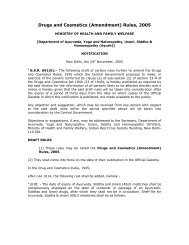
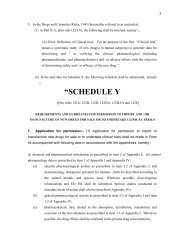
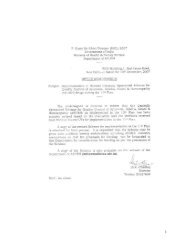

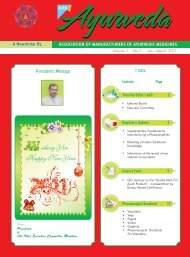

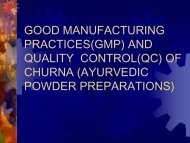
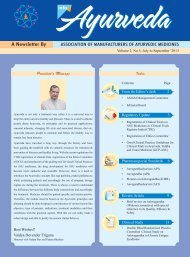
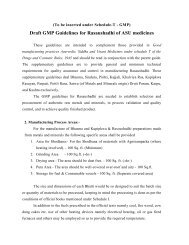
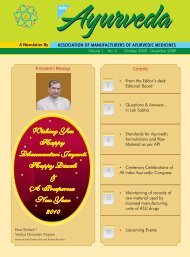
![[To be published in Gazette of India Part II Section 3, sub-section iii]](https://img.yumpu.com/28570283/1/190x245/to-be-published-in-gazette-of-india-part-ii-section-3-sub-section-iii.jpg?quality=85)
